This season’s humidity has me craving truly tame frizz and smooth, silky strands. I put this post together because I’m tired of quick fixes that fade after a wash. Hair that fights frizz should feel controllable, not a battle. So I pulled together 26 practical ways to tame frizz and keep your hair soft and easy to manage.
If you care about simple routines that work in real life, this one’s for you. If you want tips you can try this week and see real changes, you’re in the right place. This guide speaks to anyone dealing with frizz, from curly and wavy textures to straight hair that poofs in humidity. You’ll find ideas that fit a range of budgets, tools, and time limits.
Here’s what you’ll get. A complete toolkit built around 26 ways to reduce fuzz and boost shine. The tips cover washing, drying, styling, protection, and night care. Each idea comes with a quick action you can test now, like swapping to a microfiber towel or adding a light serum to your routine. You can mix and match to suit your hair type and your day.
These ideas aim to calm flyaways and keep moisture locked in. You’ll learn how to pick the right products for your texture and how to style without heat when you can. There are tricks for air drying, for low humidity days, and for sports or workdays when time is tight. The goal is a steady routine that feels gentle on your hair and your wallet.
I won’t pretend one plan fits all. Hair type, climate, and past damage all matter. Some tips work better in summer, others in dry seasons. The list gives you options so you can build a plan that sticks and still leaves room for experimentation.
Ready to start? Dive in and see which ideas spark results for you. Try a couple this week, then add more as you go. Share what helps most and I’ll stay here with more tips. The road to smooth, silky strands is yours to write, one small change at a time.
1. Coconut Oil Magic

What coconut oil does for frizzy hair
If frizz sticks to your hair, you want moisture that lasts. Coconut oil coats each strand. It seals the cuticle and keeps moisture from escaping. The result is a softer feel, smoother texture, and natural shine. It works best if you use it regularly. Give it two weeks to see changes. Start with a small amount and watch how your hair reacts.
Here is how to use it for best results
– Pre-shampoo treatment: Warm a small dab between your palms. Run it from mid-length to the ends. Leave it on for 10–20 minutes before you wash to add moisture. This extra layer helps hold moisture longer between washes.
– Overnight conditioning: For deeper softness, apply a light layer, wrap with a satin cap, and sleep. Rinse in the morning and wash as usual.
– Don’t overdo it: If your hair is fine, a pea-sized amount is enough. For thick or curly hair, you can use a bit more, but avoid heaviness. Start with the smallest amount and adjust as needed.
Next steps: With regular use, you should notice less frizz and more shine. If you see buildup or greasiness, cut back and rinse more thoroughly.
Note: Choose pure, unrefined coconut oil for best results.
Pair it with a gentle shampoo and cool water to keep the gloss.
2. Aloe Vera Boost

What aloe vera does for frizz
Dealing with frizzy hair can feel like a daily battle. Aloe vera offers a simple, gentle fix. The gel from a fresh leaf hydrates your hair and soothes your scalp. It leaves hair soft without weighing it down.
Why it helps
– Nourishes moisture and balance.
– Improves elasticity so strands bend, not snap.
– Cools and soothes a dry or itchy scalp.
How to use it
– Step 1: Cut a fresh aloe leaf and scoop out the gel.
– Step 2: Apply to damp hair and scalp. Massage gently for even coverage.
– Step 3: Leave the gel on for 5 to 10 minutes. Rinse for a light wash, or skip the rinse if you want a light leave-in boost.
Tips for best results
– Start with 1 to 2 uses per week.
– Mix gel with your regular conditioner for slip.
– Use a tiny amount of coconut oil or olive oil for shine on dry ends.
– Keep the gel in a clean container in the fridge; use within a week.
– Tip: try it on one small section first to see how your hair reacts.
What to expect
Aloe works best on mild to moderate frizz. It may not fix heavy frizz or very dry curls alone. Results vary by hair type and climate. Pair with a good conditioner and heat protection for stronger results.
3. Honey and Olive Oil Treatment

If frizz makes your hair look dull, you can beat it with a simple mix of honey and olive oil. Honey pulls moisture into the hair. Olive oil seals that moisture, giving you softer strands.
Here is why this works. Honey pulls moisture into the hair. Olive oil seals it in. The result is hair that feels smoother and looks less frizzy.
– Prepare the mix: Mix equal parts honey and olive oil. Warm it in your hands so it spreads easy. The blend smells warm and sweet.
– Apply to damp hair: Work from middle lengths to ends. If your scalp gets oily, skip rubbing there.
– Time it: Leave on for about 30 minutes before you shampoo. This lets moisture sink in.
– Rinse and wash: Rinse thoroughly to avoid any sticky film.
– Frequency: Repeat weekly for best results.
– Tips: If your hair is very fine, use a touch less oil. If it is very dry, a bit more oil can help, but not too much.
– Next steps: Try this routine for three weeks. If you see less frizz and more shine, keep it in your wash day.
After a few treatments, your strands feel smoother and easier to style. It is simple, affordable, and kind to your hair. Give it time and you will notice a lasting shine.
4. Apple Cider Vinegar Rinse

If frizz steals your smooth look, this rinse can help. Apple cider vinegar rinse is a simple, affordable step you can do at home. It smooths the hair cuticle and tames flyaways without heavy sprays. It smells tangy at first, then it fades.
Here is why it works:
– Balanced pH: The rinse helps your hair regain its natural balance, so strands lie flatter.
– Shine boost: A light wash can bring out a healthy glow.
– Buildup cleanup: It clears product grime and clarifies your scalp.
How to do it:
– Mix one part apple cider vinegar with two parts water.
– After you shampoo, pour the mix over your hair and scalp.
– Let it sit for about a minute, then rinse with cool water.
– Dry as you usually do. The cool rinse helps lock in the smooth look.
When to use:
– Try this once a week for best results.
– If your hair feels dry, increase the water ratio to dilute the vinegar more.
Tips for success:
– Do a small strand test first to check for sensitivity.
– Use a labeled bottle and shake well before each use.
– Avoid hot water and apply a light conditioner after if needed.
Notice softer, smoother hair after a few uses.
5. Avocado Hair Mask
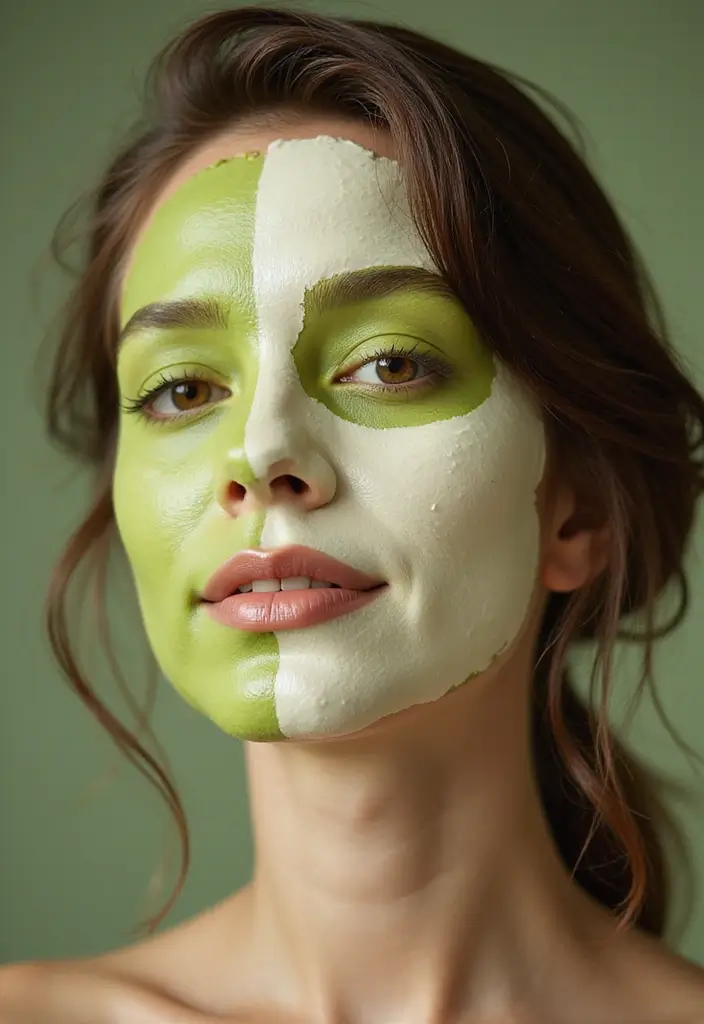
Here is the problem you face: frizzy, dry hair that won’t stay smooth. A simple fix can start in your kitchen. The avocado hair mask can help.
– What you need: one ripe avocado, 1 tablespoon olive oil.
– How to do it: Mash the avocado until smooth. Stir in the olive oil. Apply the mix to damp hair, from roots to ends. Cover with a shower cap. Leave it for 30 minutes. Rinse well and wash as usual.
Here is why it works:
– The avocado is full of vitamins E and B that feed each strand.
– The oil seals in moisture for deep conditioning.
– The mask adds natural shine and cuts frizz.
Next steps:
– Use this once a week for best results.
– If your hair is very fine, use less avocado or rinse extra well to avoid heaviness.
– For color-treated hair, skip heavy oils that can dull color; always patch test.
Extra tips:
– Mash the avocado well so it spreads easily.
– For long or thick hair, you may need a second half of the recipe.
– After washing, pat dry with a soft towel and avoid rubbing.
– Finish with a cool rinse or air dry for less flyaway frizz.
More shine follows.
6. Regular Trims

If frizz is driving you crazy, regular trims can be your best ally. Split ends catch moisture and wander up the strand, creating more frizz and a dull look. A clean, even end makes hair lie flat and shine.
Here is why a trim every 6–8 weeks helps, even if you’re growing your hair out:
– Ends stay healthy: removing dry tips lowers frizz across the length.
– Shape stays fresh: your cut looks lively, not lifeless, between washes.
– Style holds better: cleaner ends mean less flyaway and more control.
Next steps:
– Set a recurring reminder for a trim every 6–8 weeks. Treat it like a regular appointment, not a pity trim.
– Ask for a light snip, sometimes called a dusting. You lose length, not progress.
– Communicate your goal. Tell your stylist you want smoother ends, not a big change in length. A quick trim can make a big difference.
Tips for upkeep:
– Use a wide-tooth comb on wet hair to avoid snags.
– Apply a lightweight leave-in conditioner after washing to seal ends.
– Protect hair at night with a satin pillowcase to cut friction.
This simple routine keeps frizz in check and your hair looking glossy and healthy.
7. Use a Microfiber Towel

Frizzy hair can start in the drying stage. A microfiber towel is gentler on strands and cuts the rubbing that makes frizz.
Here is how to use it:
– After washing, squeeze out water gently. Do not rub hard.
– Wrap your hair in the microfiber towel and let it sit for 5 to 8 minutes.
– Then air dry or style as you usually do.
Why this helps:
– Prevents breakage: Less friction means fewer split ends.
– Absorbs moisture: The tiny fibers soak up water without roughing the cuticle.
– Frizz minimization: Hair dries smoother and lies flatter.
Quick tips to get the most from it:
– Choose a towel labeled 100% microfiber or a microfiber blend.
– Avoid fabric softeners and dryer sheets; they coat fibers and reduce absorbency.
– Do not rub. Pat and lift for a gentle dry.
– If you have long or thick hair, pick a larger towel to cover more hair at once.
– Wash the towel after a few uses with mild detergent and skip fabric softener to keep fibers clean.
Next steps:
– If you air dry, keep the towel on until your hair is just damp.
– Finish with a light leave‑in product to seal moisture and tame flyaways.
– If you want an extra nudge, this simple switch can help your hair stay calmer and smoother.
Ditch the rough towels! Using a microfiber towel can make a world of difference, gently reducing frizz while keeping your strands smooth and silky. Your hair will thank you for this simple switch!
8. Avoid Heat Styling

Frizz loves heat. Blow dryers, curling irons, and flat irons pull moisture from hair and rough up the cuticle. The result is dull, stiff strands that refuse to lie flat. You can bend this trend by skipping heat when you can.
Here is how to tame frizz with less heat. Air drying is gentle and costless. Gently blot with a towel, then let your hair air dry or finish with a cool setting. A softer routine keeps moisture in and helps hair look smoother. A satin pillowcase also cuts friction at night, helping strands stay tame.
– Lower heat when you must: If you need a style, use the lowest heat setting. Keep the tool moving and away from the roots to avoid over-drying.
– Protect before you style: Always spray a heat protectant from roots to tips. Look for formulas with lightweight shields that vanish as hair cools.
– Try no-heat styles: Wet hair works best here. Braid it for waves, or wrap small sections around foam rollers for soft curls. A dab of mousse can hold the look without heat.
– Finish with a cool touch: End with a cool air blast to seal the cuticle and set the texture. Let hair settle before touching it.
Your hair will reward the lighter touch with smoother, silkier shine.
9. Natural Oils for Nourishment

Natural Oils for Nourishment
Frizz makes hair look dull and feel dry. You want smooth strands that stay soft all day. Natural oils can help. They add moisture where your hair needs it most. If your hair is brittle or very dry, oils can be a simple boost between washes.
Here is why: oils such as argan, jojoba, and almond hydrate and protect. They work well for keeping frizz at bay and shine alive.
Oil options you can rely on:
– Argan oil for shine and conditioning.
– Jojoba oil for balanced moisture without a heavy feel.
– Almond oil for gentle nourishment and scent.
How to use them:
– Warm a few drops in your palms.
– Rub hands together to spread evenly.
– Lightly run through your hair, focusing on mid lengths and ends.
What you get:
– Deep hydration. The oils seep into the hair shaft to lock in moisture.
– Frizz control. They smooth the cuticle so humidity stays outside.
– Natural shine. Hair feels softer and looks healthier.
Next steps:
– Start with 2-3 drops to test tolerance, especially if your hair is fine.
– Apply after washing as a finishing touch, or on dry hair for a quick tame.
– Avoid applying at the scalp if your roots get oily easily.
10. Hydrating Hair Products

If frizz is a daily battle, hydrated hair is your strongest ally. Hydrating products help your strands hold moisture so they stay smoother and resist puffing up in humidity.
Here is why this works: moisture softens the cuticle, reduces static, and makes combing easier. Now, let’s break it down with practical choices you can trust.
– Choose a moisture-focused shampoo and conditioner. Look for formulas labeled hydrators or moisture rescue.
– Read the label. Skip sulfates and parabens. Gentler cleansers protect your ends.
– Add a leave-in conditioner. It keeps moisture alive after you wash and dry.
– Try an anti-frizz serum. A tiny line from mid-length to ends can tame flyaways all day.
– Layer thoughtfully. Cleanse, condition, then apply leave-in. Finish with a light serum if needed.
– Use smart drying. Gently blot hair with a towel; avoid rubbing. Air-dry when you can.
– On humid days, slick a small amount of serum through mid-lengths to ends before styling.
– Choose formulas for your hair type. For fine hair, pick lighter formulas. Thick or curly hair can take a touch more product.
– Be realistic. Moisture helps, but trims fix split ends. Expect smoother texture with consistent use.
– Next steps. Keep a short routine, watch for buildup, and adjust as your hair changes with the seasons.
You might also like
11. Humidity Control Products

Humidity can turn hair into frizz. You want control, not a daily battle. Humidity control products keep strands smooth all day.
What to look for
– Anti-humidity sprays that seal your style with a light mist.
– Frizz creams that form a thin shield.
– Hair oils with humidity protection that nourish and guard the ends.
Look for labels that say humidity resistance.
How to use them
Start with clean, damp hair.
– Spray a gentle layer over your finished style from a short distance. Let it dry.
– Rub a small amount of frizz cream between your palms and smooth onto lengths. Skip the roots to keep volume.
– Warm a drop of hair oil and run it through mid-lengths to ends for shine and a final seal.
Simple routine tips
– Use one product at a time or layer light formulas.
– For fine hair, pick lighter formulas to avoid heaviness.
– On humid days, refresh with a quick spray or a touch of oil.
Common questions
– Will this make hair stiff? Start small and add if needed.
– Do these work in humidity? They help, but weather can still challenge hair. Adjust amount and timing.
Next steps: test one anti-humidity spray, one frizz cream, or a light oil this week.
12. Silk or Satin Pillowcases

Why silk or satin pillowcases help
If frizz slows you down in the morning, your bed setup could be the culprit. A cotton pillowcase can tug at strands as you sleep. Silk or satin offers a softer ride for your hair. Here is why it works.
– Less friction: Hair glides across the fabric instead of catching.
– Fewer breaks: Less tugging means fewer split ends.
– Better moisture: Silk and satin don’t soak up your natural oils as fast as cotton.
– Smoother wake up: Your hair looks calmer when you rise.
How to try it now
Next steps to try it now.
– Pick the fabric: Silk is a natural fiber. Satin is a smooth weave that feels similar but often costs less. Both cut frizz well.
– Make it fit: Use a pillowcase that covers the pillow well and stays in place all night.
– Care for it: Wash in cool water with a mild detergent. Air dry away from heat. Do not iron silk with hot heat.
How to get the most from this tip
– Try it for a week and note changes in the morning.
– Pair with a lightweight leave-in or balm if your hair is dry.
– Keep expectations real; this helps with frizz but it cannot fix every issue.
Ready to switch?
13. Essential Oils for Frizz Control

Frizzy hair can be a daily frustration. You want smooth strands that stay put. Oil blends can help you tame frizz without heavy products.
Here is why they work:
– Natural scents make hair smell nice.
– They may support a healthy scalp and growth.
– They add moisture to dry strands.
Choose oils that fit your goals. Lavender gives a calm scent. Rosemary can refresh the scalp. Cedarwood adds shine and helps manage frizz.
Next, practical uses:
– Add a few drops to your regular conditioner.
– Or make a DIY spray: mix 6-8 drops in 1 cup water. Shake well before use.
For more moisture, add a little carrier oil such as jojoba or almond.
Patch test first and wait 24 hours.
Avoid eyes.
Store the bottle away from heat and sunlight. Use a small amount on damp hair for best results. If you notice any irritation, stop using it right away.
Simple routines:
– Use the spray after washing, then comb gently.
– Apply a tiny dab to ends, not the roots.
– Store the blend in a dark bottle away from heat.
These steps give you softer, calmer hair. Try one blend this week and adjust based on how your hair feels.
Give it a try today.
14. Be Mindful with Hair Accessories
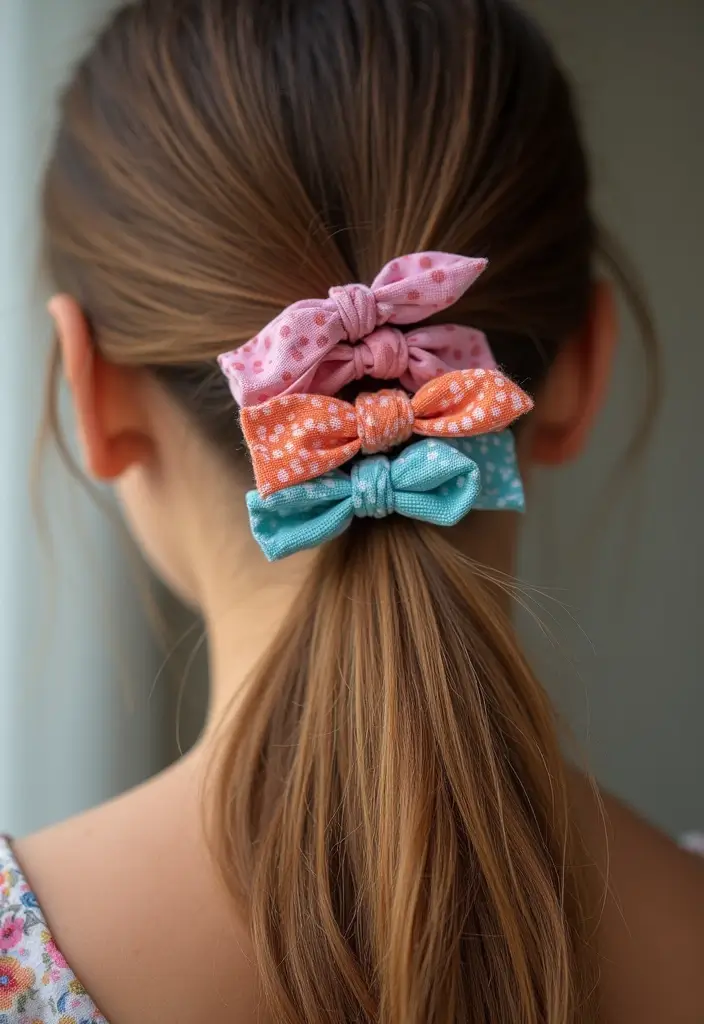
If frizz pops up after you style, the problem might be your accessories. Small choices can reduce friction and save your hair from breakage. You can tame frizz by picking the right ties and clips, and by softening how you wear your hair.
What to choose
– Use fabric-covered hair ties. They’re gentler than rubber bands and prevent snagging on dry ends.
– Pick smooth clips. Look for rounded edges and a soft finish to glide through hair.
– Go for satin or silk options. Satin scrunchies or scarf wraps reduce rubbing on strands.
– Favor loose, low styles. Tight ponytails pull hair and lift frizz, so opt for a relaxed look when you can.
– Avoid metal fasteners with rough edges. If a clip feels scratchy, test another style.
– Consider no-clip updos. Soft pins or behind-the-ear placements can hold hair without stress.
– Clean your gear weekly. Dust and oils can transfer to hair and add frizz.
Practical tips
– Rotate styles to avoid stressing the same spot every day.
– Let hair breathe between updos for best shine.
These simple steps cut frizz and help strands stay smooth all day.
15. Hydrate from Within

Hydration from Within
If frizz is your issue, fix it inside first. You need water to keep hair healthy. When you drink enough, your scalp stays fed and strands stay softer.
Here is why water matters:
– It supports growth. Hair follicles work best when you are hydrated.
– It reduces dryness and frizz. Moisture helps your hair hold its shape.
– It helps your whole body. Clear skin and strong nails can help hair look better.
Next steps you can try today:
– Aim for about 8 cups of water each day. In hot weather or after workouts, drink a bit more.
– Make it easy. Carry a reusable bottle. Sip a glass before meals. Quick refills between tasks help a lot.
– Add water through food. Eat fruits and vegetables with high water content, like cucumber and melon, plus broth-based soups.
– Watch the signs. Clear urine and steady energy usually mean you are on track.
Water helps, but it won’t fix every frizz. Humidity and heat can still affect hair. Hydration is a solid base.
Next steps for a simple routine: start with a morning glass, a midday refill, and a cup of herbal tea in the evening.
To tame frizzy hair, start from within: hydrate! Drinking enough water not only nourishes your strands but also boosts growth and reduces dryness. Remember, a hydrated body leads to healthy hair!
16. Experiment with Braids

Frizz at night can wake you with puff and flyaways. Braiding damp hair helps tame frizz and makes soft waves. It is a simple trick you can do before bed.
Here is how to get results quickly:
– French braid: For a defined wave. Start at the crown, grab small sections, and cross them over as you go. Keep the braid loose so the waves form naturally.
– Loose side braid: For a relaxed look. Let hair fall to one side, braid loosely, then secure. This keeps hair together while you sleep.
– Fishtail braid: For texture and interest. Split hair into two thin sections, swap small pieces from each side, and keep it gentle.
Here is why it works: damp hair holds shape better than dry hair. The braid acts like a small mold, guiding strands into soft bends rather than frizz. It also stops tangles while you sleep.
Next steps: wash and condition as you normally would, pat hair dry, and apply a light leave-in. Braid while the ends stay damp, then sleep on a satin pillowcase for extra smoothness. In the morning, undo gently, run your fingers through, and you’re ready to go.
Braiding damp hair before bed is your secret weapon against frizz! Wake up to soft waves and tame those flyaways with just a few simple twists. You’ve got this!
17. Avoid Over-Washing

If frizz keeps showing up, your wash schedule might be the culprit. Washing too often can strip natural oils, leaving hair dry and puffy. Give your strands a break and watch how they behave.
– Dry shampoo: Dry shampoo soaks up oil at the roots and refreshes your look without a full wash. Spray lightly at the scalp, wait 60 seconds, then brush through. It adds lift and makes curls bounce.
– Find your rhythm: See how your hair reacts day to day. Try washing every other day for a week. If it stays smooth, keep that rhythm. If it feels heavy, add a midweek refresh with dry shampoo.
– Scalp focus: When you wash, work soap into the scalp with your fingertips. Focus there and avoid rubbing the ends. Rinse well so soap doesn’t cling to the hair and dry it out.
– Cool rinse: Finish with a cool or lukewarm rinse. It helps seal moisture and tame flyaways. Gently pat hair dry with a towel and comb damp hair with a wide tooth comb.
– End care: Apply a light leave-in conditioner or a small dab of hair oil to damp ends. Keep products off the scalp to prevent buildup. This keeps ends soft until your next wash.
Cut back on wash days and your hair can stay softer, shinier, and less frizzy.
18. Cool Water Rinse

Finish with a cool water rinse
Frizz can sneak in after a warm shower. A cool rinse is a simple step that can make a big difference. It helps seal the hair cuticle, so strands stay smoother and shine more.
– It locks in moisture. Cold water helps your hair keep what it has just absorbed.
– It boosts shine. A tight cuticle reflects light for a glossy look.
– It refreshes the scalp. The chill can wake up roots and feel fresh on hot days.
Here is how to make it work for you.
– Finish your shower with a cool rinse for 10 to 30 seconds. Start warm, then ease into cooler water.
– If your hair color is color-treated, keep the rinse cool but not icy to protect color.
– Gently blot with a microfiber towel. Avoid rubbing to cut down frizz.
– Use a wide-tooth comb when hair is damp. This helps prevent breakage.
– Lock in moisture with a light leave-in conditioner or serum right away.
Next steps: Pair this rinse with a healthy routine. Don’t rely on it alone. Combine with a good conditioner and smart styling to keep frizz low.
19. Create a Hair Care Routine
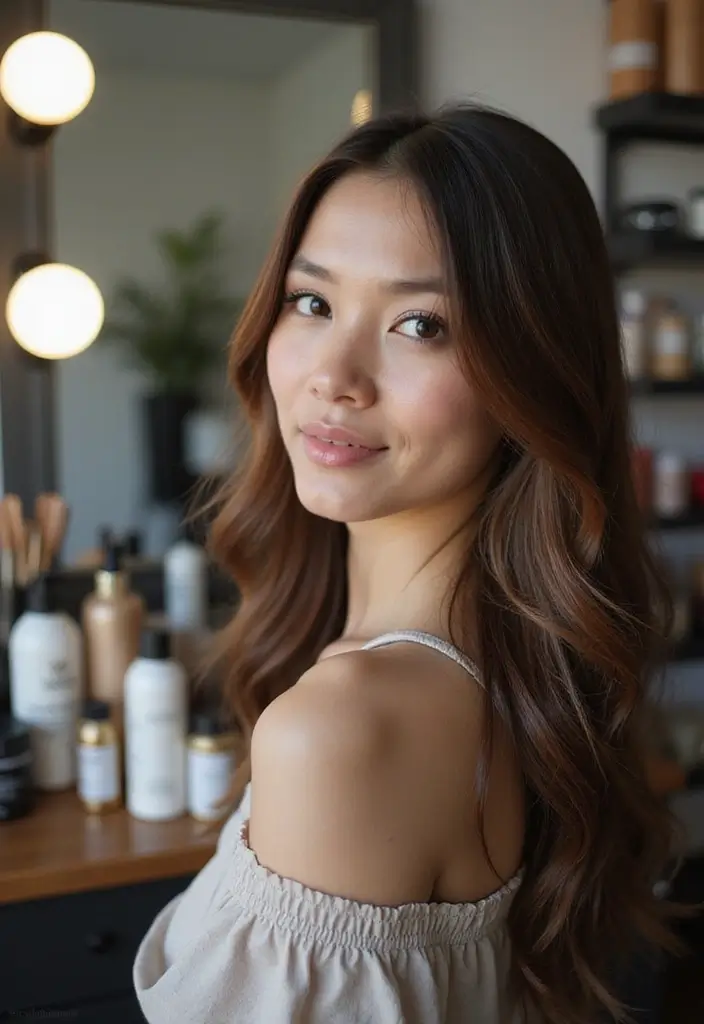
Why you need a simple hair care routine
A steady plan helps tame frizz. Repeating the same steps gives your hair a chance to hold moisture and stay smoother.
Your basics routine
– Cleanse with a gentle shampoo. Pick one that suits daily use and is light on harsh ingredients.
– Condition the mid to ends. Look for moisture-locking ingredients like glycerin and a soft silicone.
– Add moisture after washing. Use a leave-in conditioner or a light cream.
– Protect as you style. Apply a heat shield if you use heat tools. If you air-dry, use a wide-tooth comb on damp hair.
Choosing the right products
– Fine hair: a light conditioner and a small dab of oil on the ends.
– Thick or curly hair: richer creams or serums to seal moisture.
– Color treated: color-safe formulas.
Keep it steady and adapt
– Do the routine at the same time each day. Consistency matters more than flair.
– Adjust with the seasons. Humidity calls for extra moisture; dry air needs weekly masks.
Two practical plans
– Daily: shampoo, light conditioner, leave-in spray, air-dry.
– Weekly: deep conditioner mask and a richer serum.
Next steps
– Start tomorrow and notice smoother strands in about a week.
Tip
Tweak the steps to fit your hair.
You Might Also Like
20. Avoid Chemical Treatments

If frizz keeps winning, pick a gentler path. Skipping harsh chemicals can make hair softer and easier to manage. Here is why and how you can start today.
Here is why staying chemical-free helps.
– Choose natural options: Look for styling products that use plant oils, shea, and aloe. They tame flyaways without harsh chemicals. Check for sulfate-free formulas. This helps scalp health and adds shine.
– Give your hair a break: Limit perms and straightening. Give hair weeks between treatments. Ask your stylist about milder options and aftercare tips. Skip heat between sessions when you can.
– Consult with professionals: If you still want a straight or curly look, choose the gentlest method and a clear aftercare plan. Write down steps and follow them.
– Care between chemical styles: Deep-condition weekly and use heat protection when you blow dry. Run a light oil on the ends to seal in moisture.
– A practical benefit: A chemical-free routine can cut frizz, keep color truer, and make brushing easier. Your hair drinks less water, so tangles are fewer.
– Be mindful of tools and sessions: Choose wide-tooth combs and soft brushes. Let hair air-dry when possible and keep heat low when you must style.
Start with one change this week. Track how your hair feels and looks, then adjust as you go.
Start small, stay consistent, and you will see less frizz in a few weeks. Tell a friend and keep going.
21. Embrace Leave-In Conditioners
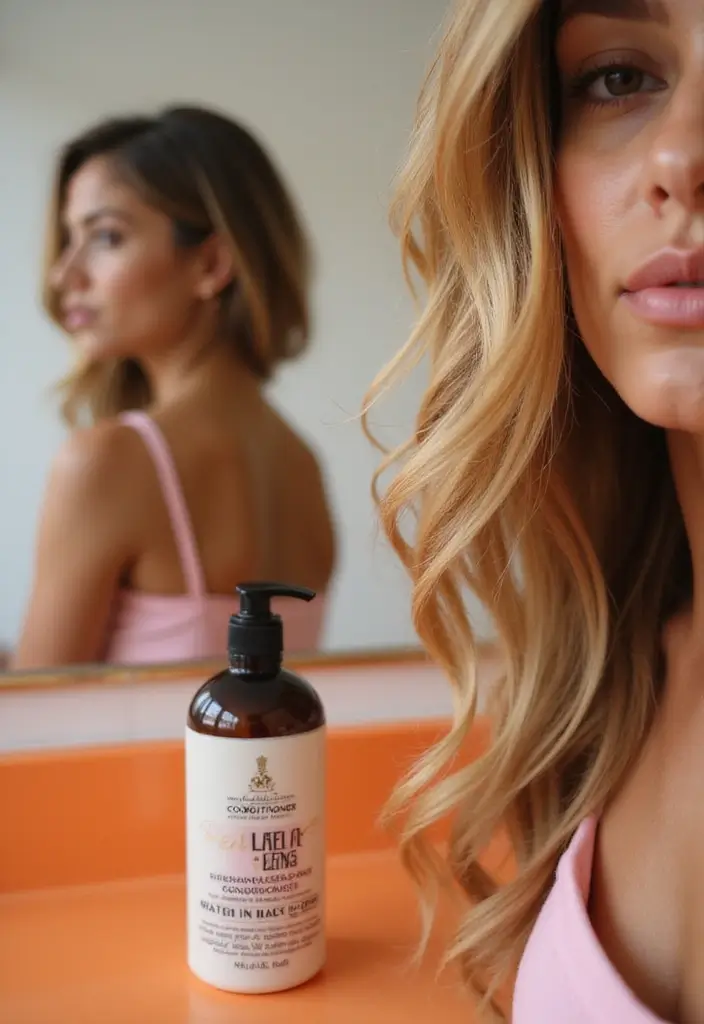
Frizz shows up when your hair dries out. You want smooth, silky strands that stay put all day. Leave-in conditioners lock in moisture after you wash and help control frizz.
Here is why they work:
– Hydration that lasts: They form a light shield on your hair so moisture sticks around.
– Easy styling: They soften strands, so brushes and combs glide.
– Smooth, shiny texture: They calm the surface for a natural glow.
Next steps:
use them on damp hair for best results.
– Start with a small amount. Short hair uses a pea-size; long hair may need a dime-size.
– Rub it between your palms, then smooth through mid-length to ends.
– Skip the roots to avoid heaviness.
If humidity spikes, reapply to the mid-length and ends to keep frizz away.
Tips you can try today:
– Choose a water-based formula if your hair is thin. It won’t weigh you down.
– Keep a travel-size bottle in your bag for touch-ups after workouts.
With these steps, leave-in conditioner becomes a simple habit that brings lasting softness and less frizz.
22. Use a Comb Instead of a Brush

If you want smoother hair and less frizz, switch from a brush to a wide-tooth comb. Wet hair is fragile and can break easily. A comb glides through strands, so you won’t yank and create more frizz.
Here is how to use it:
– Start at the ends. Begin at the tips. Slowly work your way up to the roots to avoid snagging. This helps keep strands intact.
– Use on damp hair. Detangle while your hair is still damp. A little moisture makes the fibers bend and slide.
– Be gentle. Hold a section taut with one hand. Glide the comb with the other in small, smooth moves.
– Choose the right tool. Pick a wide-tooth comb made of wood or sturdy plastic. It should glide, not pull or snap.
– Finish with care. When you are done, pat hair dry with a towel. Then run your fingers through to loosen any knots.
If your hair is very tangled, detangle in extra small sections and be patient. A quick, rough pass can cause more frizz.
Next steps: apply a light leave-in conditioner or a smoothing serum to seal moisture at the ends.
23. Try No-Poo Method

If frizz is making your hair look puffy and dry, a no-poo routine can help. This approach keeps your natural oils, so strands stay softer and less frizzy. It takes a little time to adjust, but many people see calmer hair after a few weeks.
Here is how to try it:
– Conditioner wash: Use a silicone-free, moisturizing conditioner to wash your hair. Let it coat your strands like a gentle soap, then rinse.
– Rinse thoroughly: Rinse until the water runs clear. No sticky film should stay behind.
– Introduce gradually: Start slow. Try a conditioner wash every 2 to 3 days at first. If your hair or scalp feels weighed down, ease off or skip a wash.
Why this helps: your scalp keeps more of its natural oils. Hair stays hydrated, so frizz stays down. Over time you may notice smoother, shinier strands and fewer flyaways.
Next steps and tips:
– If you see buildup, switch to a lighter silicone-free conditioner with gentle hydration.
– For dry ends, apply a tiny amount of leave-in conditioner or a lightweight serum just to the tips.
– Wash with cool to warm water. Hot water can strip oils and lift frizz.
Common questions: Will this dry my scalp? If you pace the change, most people keep a balanced scalp and soft hair. How long before you see smooth hair? Expect a few weeks. Stay steady, listen to your hair, and adjust as needed.
24. Incorporate Herbal Rinses

Frizz creeping in? A simple herbal rinse can help you get smooth, shiny hair. It hydrates softly and cuts that dry, fluffy look. Chamomile, hibiscus, and nettle give moisture, gloss, and strength.
What you need
– Chamomile flowers or tea bags
– Hibiscus petals
– Nettle leaves
– Water
– A clean bottle for storage
How to make it
1) Boil water and add the herbs. Turn off the heat and steep for 20–30 minutes.
2) Strain the mix and let it cool completely.
3) After you wash with shampoo, pour the rinse over your hair. Massage from scalp to ends and leave it in for about a minute. Rinse with cool water or keep it in if you like.
4) Store any extra rinse in the fridge for up to 7 days. Shake before using.
Why this helps
Here is why this works. It adds natural moisture and makes frizz softer. The cuticle lays flat for smoother strands. You may notice a light herbal scent and a softer feel. It also works well on dull, dry hair.
Tips
– Do a patch test if your scalp is sensitive.
– Start with 1–2 times a week and adjust as needed.
This is a gentle, practical way to tame frizz with ingredients you can trust.
25. Nutrition for Healthy Hair

Nutrition for Healthy Hair
You want smooth, frizz-free hair. The inside of your body shows on the outside.
Here is how to fuel healthy hair.
Small, steady meals help your scalp stay hydrated.
– Omega-3 fatty acids: Look to fish like salmon or tuna, and add flaxseeds to meals. They help hydrate strands from the inside.
– Protein: Hair is built from protein. Make eggs, beans, and lentils regular in your week. A simple plate can be eggs at breakfast and beans at lunch.
– Vitamins A, C, and E: Choose bright fruits and leafy greens. Carrots, spinach, berries, citrus all help hair stay strong and glow.
– Water and balance: Drink water through the day. Limit too much sugar and too many processed snacks.
How to put this into action:
– Build each day around a protein, a fruit or veggie, and a healthy fat.
– Add two servings of omega-3 foods in the week.
– Snack on yogurt with fruit or a handful of seeds for steady energy.
– Keep meals simple so you actually stick with them.
What you gain: less frizz, shinier strands, and fewer breakages. You’ll feel more confident with hair you can style with ease.
Next steps: start with one small change today and build from there.
Nourish your body, and your hair will thank you! Fuel up with omega-3s and protein for those smooth, frizz-free strands. Remember, beautiful hair starts from the inside out.
26. Use a Humidity-Resistant Hair Serum
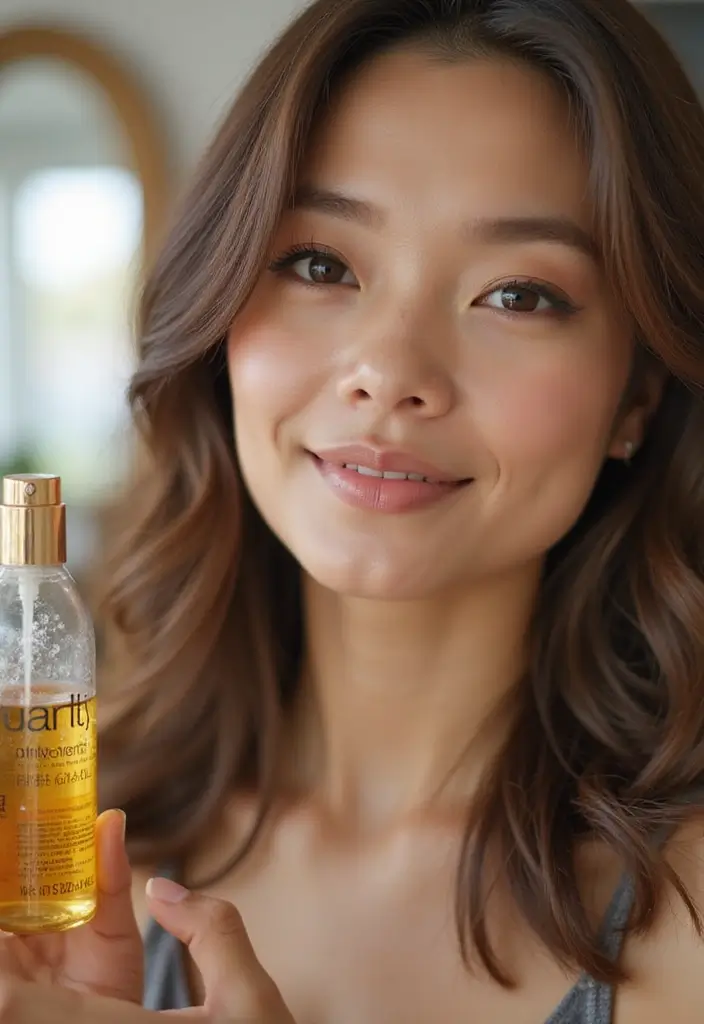
If humidity makes your hair puff up, you’re not imagining things. You want smooth, silky strands that stay calm in damp air. A humidity-resistant hair serum can seal the cuticle, boost shine, and keep frizz in check.
Here is how to pick and use one that fits you.
– Lightweight formulas – Choose a serum labeled lightweight or oil-free. It should feel barely there, not heavy.
– Apply before styling – On damp hair, warm a pea-size amount between your palms. Run it through from mid-lengths to ends. This primes the hair before heat and products.
– Reapply as needed – If frizz returns during the day, add a tiny drop to frizz-prone areas. A little goes a long way.
– Match your hair type – Fine hair needs less product. Thick or curly hair can handle a touch more. Start small and build up.
– Check the ingredients – Silicone-based serums help seal the cuticle and add shine. If you avoid silicone, look for a water-based option and still apply on damp hair for best results.
How to use in practice
– Start with clean, towel-dried hair.
– Apply the serum to the mid-lengths and ends only.
– Comb through to distribute evenly.
– Style with a blow-dryer on medium heat or let it air-dry.
– Finish with a second, light touch if needed.
Next steps: keep a small bottle in your bag for quick touch-ups. With the right humidity-resistant serum, you’ll tame frizz and enjoy smoother, shinier strands all day long.
Conclusion

Waving goodbye to frizzy hair doesn’t have to be a distant dream!
With these 26 fabulous tips and natural remedies, you’ll be on your way to smooth, silky strands in no time.
Try incorporating a few of these methods into your hair care routine and enjoy the transformation!
Frequently Asked Questions
What are some effective natural remedies for taming frizzy hair?
If you’re tired of dealing with frizzy hair, natural remedies can be your best friends! Consider using coconut oil to seal moisture in your strands or try an aloe vera treatment for hydration. A simple mix of honey and olive oil can also work wonders to combat dullness and enhance softness. These remedies not only tame frizz but also promote healthier hair over time!
How can I adjust my hair care routine to control frizz effectively?
Creating a consistent hair care routine is crucial for managing frizz. Start by using hydrating hair products and incorporate leave-in conditioners to lock in moisture after washing. Additionally, try avoiding heat styling and consider regular trims to eliminate split ends that can worsen frizz. A cool water rinse at the end of your shower can also help seal the cuticle for smoother strands.
What should I look for in anti-frizz products?
When shopping for anti-frizz products, aim for those labeled as humidity-resistant. Look for anti-humidity sprays that seal the hair cuticle to prevent moisture from causing frizz. Additionally, products containing natural oils can nourish your hair and keep it smooth. Always choose products that fit your hair type for the best results!
Can diet and hydration really impact frizz in my hair?
Absolutely! The food you eat and how much you hydrate play a significant role in the health of your hair. Ensure you’re drinking enough water to keep your scalp and strands hydrated. Incorporate foods rich in vitamins and minerals, like avocados and nuts, to nourish your hair from the inside out. A balanced diet will help maintain your hair’s moisture levels and reduce frizz.
How can I manage frizzy hair in humid weather?
Humidity can be a nightmare for frizzy hair, but there are ways to combat it! Use humidity control products that help seal your hair cuticle. Consider wearing your hair in braids or a loose bun to minimize frizz when it’s particularly humid. Additionally, switching to silk or satin pillowcases can reduce friction while you sleep, helping you wake up with smoother hair!
Related Topics
frizzy hair solutions
natural hair remedies
smooth hair tips
humidity control
anti-frizz products
hair care routine
easy hair treatments
coconut oil benefits
aloe vera uses
hair hydration
leave-in conditioners
no-poo method























